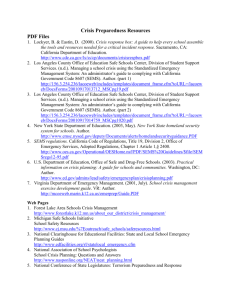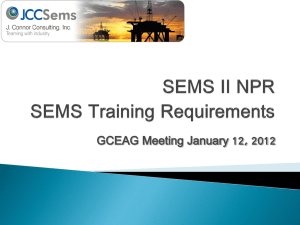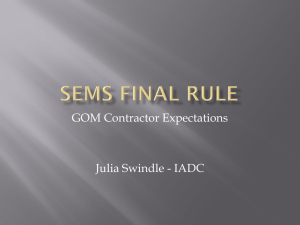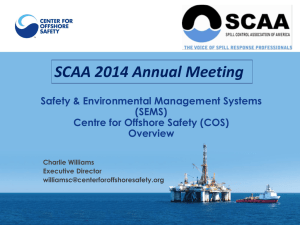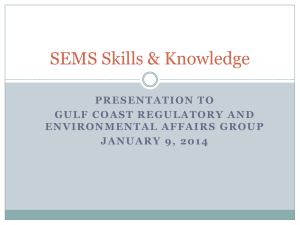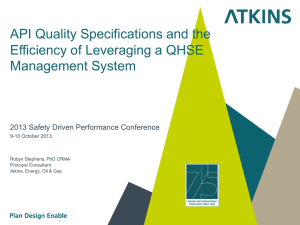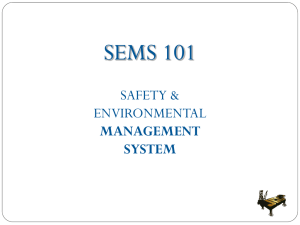Document
advertisement
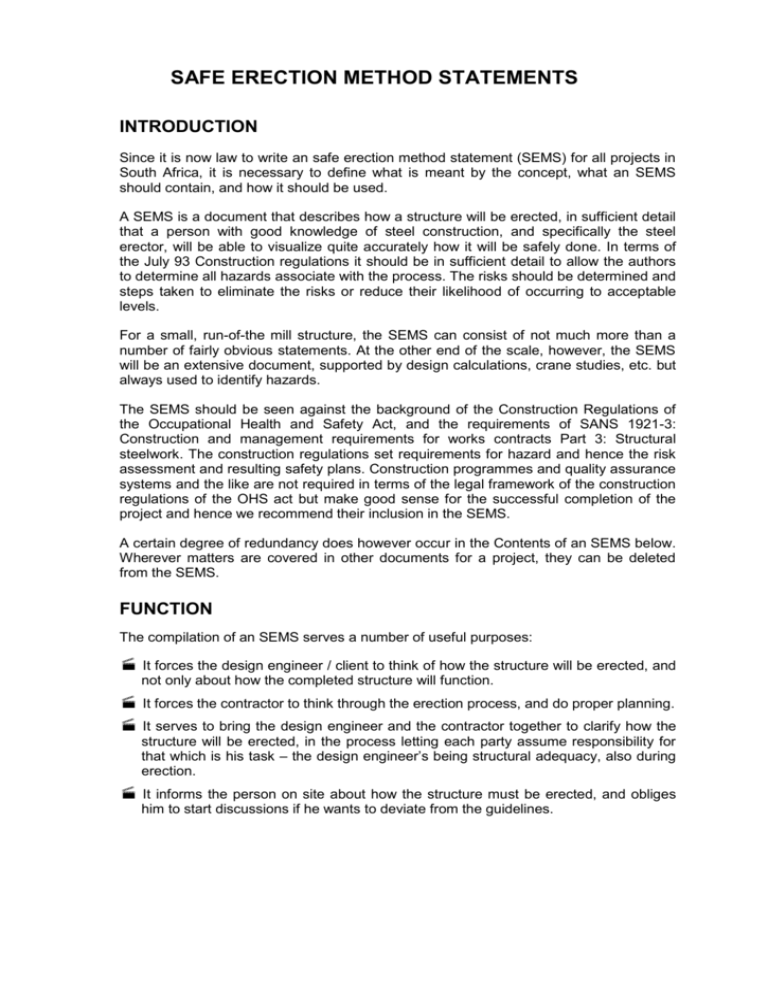
SAFE ERECTION METHOD STATEMENTS INTRODUCTION Since it is now law to write an safe erection method statement (SEMS) for all projects in South Africa, it is necessary to define what is meant by the concept, what an SEMS should contain, and how it should be used. A SEMS is a document that describes how a structure will be erected, in sufficient detail that a person with good knowledge of steel construction, and specifically the steel erector, will be able to visualize quite accurately how it will be safely done. In terms of the July 93 Construction regulations it should be in sufficient detail to allow the authors to determine all hazards associate with the process. The risks should be determined and steps taken to eliminate the risks or reduce their likelihood of occurring to acceptable levels. For a small, run-of-the mill structure, the SEMS can consist of not much more than a number of fairly obvious statements. At the other end of the scale, however, the SEMS will be an extensive document, supported by design calculations, crane studies, etc. but always used to identify hazards. The SEMS should be seen against the background of the Construction Regulations of the Occupational Health and Safety Act, and the requirements of SANS 1921-3: Construction and management requirements for works contracts Part 3: Structural steelwork. The construction regulations set requirements for hazard and hence the risk assessment and resulting safety plans. Construction programmes and quality assurance systems and the like are not required in terms of the legal framework of the construction regulations of the OHS act but make good sense for the successful completion of the project and hence we recommend their inclusion in the SEMS. A certain degree of redundancy does however occur in the Contents of an SEMS below. Wherever matters are covered in other documents for a project, they can be deleted from the SEMS. FUNCTION The compilation of an SEMS serves a number of useful purposes: It forces the design engineer / client to think of how the structure will be erected, and not only about how the completed structure will function. It forces the contractor to think through the erection process, and do proper planning. It serves to bring the design engineer and the contractor together to clarify how the structure will be erected, in the process letting each party assume responsibility for that which is his task – the design engineer’s being structural adequacy, also during erection. It informs the person on site about how the structure must be erected, and obliges him to start discussions if he wants to deviate from the guidelines. Most things that can potentially go wrong (including the non-provision of information) can be handled better if a good SEMS is compiled. Correctly compiled the SEMC will lead to hazard identification, from which a risk assessment can executed and steps taken to eliminate the risks or lower them to acceptable levels. Thus the SEMS serves to promote communication, thought, discussion and clarification, which will inevitably lead to improved safety and productivity and elimination of ambiguities and misunderstandings. CONTENTS OF AN SEMS An SEMS may contain the following headings, the contents of which (statements, instructions, reminders, hazards) may be placed, partially or in total, in appendices or separate documents: 1. IDENTIFICATION 1.1 Identification of the project 1.2 Identification of method statement and revisions 1.3 Approval of method statement by Design engineer and/or client’s representative - Main contractor - Steelwork contractor Person in control of steelwork erection - Safety personnel 2. OVERVIEW 2.1 Brief description of the structure including its basic dimensions. 2.2 Elements to be erected 2.2.1 2.2.2 2.3 The size and mass of the largest members to be lifted, as well as out of the ordinary members. Description (and reference to detail drawings) of elements to be erected. Reference to any other documents, as required 3. GENERAL CONSIDERATIONS 3.1 Signage & barricading to eliminate potential hazards (Refer to Safety Plan if appropriate.) Satisfactory identification of hazards will lead to minimization of risk 3.2 Methods of providing safe personnel access at heights. See SAISC documentation elsewhere in this regard. (Ladders, scaffolding, temporary platforms, safety lines etc.) (Refer to Safety Plan if appropriate.) 3.3 3.4 Main structural tolerances applicable (List for ease of reference on site, if deemed appropriate.) Physical constraints to the construction process that need to be taken into account, both from the practical approach as to how to the work but also to identify potential hazards and how theses constraints will be overcome: 3.4.1 3.4.2 3.4.3 3.4.4 3.4.5 3.4.6 3.4.7 3.4.8 3.4.9 3.4.10 overhead cables or other above-ground obstructions poor soil conditions underground services location of open excavations or ground edges dimensions or topography of site transportation and access, and limits to size and weight of assemblies limitations imposed by neighbours preventing damage to existing structures or equipment keeping operations of an operating facility going during construction climatic and environmental conditions 3.5 Positions, sizes and specifications of hard standings (See also 5.6) 3.6 Coordination and arrangements for cooperating with other contractors 3.7 Arrangements for site welding 3.8 Calculations and drawings prepared to analyse the structure and assess its stability during each phase of the erection process. 3.9 Weather 3.9.1 Weather conditions under which lifting or other work may not be Undertaken (Refer to Safety Plan if appropriate.) 3.9.2 Timing of complex, heavy lifts to minimize risk of adverse weather conditions (e.g. dawn) 3.10 Security of site against theft or access by unauthorized people 3.11 Loads imposed on the structure during erection from stacking of materials etc. 4 ON GROUND ACTIVITIES 4.1 Checking of foundations and/or items embedded in concrete for level and position, or of HD bolt locations relative to gridlines, or provision of as-built positions by the client. 4.2 Checking of suitability of access to site and laydown area. 4.3 Checking of condition of laydown area and its suitability for storing steelwork. 4.4 Offloading and storing to the laydown area so as to minimize damage, distortion and hazards of poor stacking. (Additional consideration to be given to unusual or abnormal assemblies.) 4.5 Checking of hard standings. 4.6 Checking of routes for cranes and for transport of steel on site. 4.7 Trial assemblies, mock-up, fit-up and trial erection eliminate problems prior to erection. 4.8 Lifting brackets / safety attachments to members to be analysed by the design engineer. (Preferably workshop fitted.) 4.9 Marking of centres of gravity on large or irregular assemblies. 4.10 Services that will be provided on site: 4.10.1 provided by the construction company 4.10.2 provided by others 4.10.3 sharing with others 5 ERECTION EQUIPMENT 5.1 Attributes of the crane(s) will be used: 5.1.1 5.1.2 5.1.3 5.1.4 5.1.5 5.2 make, model number and type crane capacity boom length crane dimensions lifting capacity at radius applicable to each major member Ownership cranes 5.2.1 5.2.2 5.2.3 construction company main contractor/client hired equipment 5.3 Where certificates for the cranes, drivers and lifting gear will be kept. 5.4 Inspection of damage to jibs, ropes, hydraulics etc. 5.5 Current test certificates for safe working loads of lifting gear. 5.6 Crane lift studies, including slings type, strength and length and method of attaching slings to steel, lifting lugs and the like and hazards associated with the lifts. Methods of ensuring people do not stand under lifting loads but also ensure that they stand in generally safe places during lifts. 5.7 Required load bearing capacity of hard standing for the crane and its outriggers. (see also 3.7) 5.8 Authorized crane operator(s) and banksman / signalman to operate cranes / sling loads and to give signals. 5.9 Lifting equipment, and design of custom made lifting equipment. 5.10 Care and storage of power tools and equipment. 5.11 Log to be kept of equipment that will be used on site at each stage: 5.11.1 provided by the construction company 5.11.2 provided by others 5.11.3 sharing equipment with others 6 ERECTION METHODOLOGY 6.1 6.2 Preparation for base plates Assembly work to be carried out at ground level to eliminate hazards of making many connections in the air, but also to ensure improved productivity. 6.3 Basic strategy to be adopted 6.4 Temporary bracing and supports: 6.4.1 6.4.2 details of such bracing and supports when and how to remove 6.5 Step by step description of each maneuver for the project 6.6 Route of lift path for each lift to avoid obstructions 6.7 Setting up and handling of cranes 6.8 Tandem and other special lifts 7 POST ERECTION 7.1 Alignment and final bolt tightening 7.2 Touching up of damaged paint, and site painting 7.3 Handing over and signing off to provide access to following trades USE OF THE SAFE ERECTION METHOD STATEMENT The SEMS shall be submitted to the design engineer and/or client for his approval. The design engineer and/or client must satisfy himself that the structure will not be subjected to excessive forces and deformations during erection if it is erected in accordance with the SEMS, and that the objectives of his design will be achieved. Many of the points listed under the contents of the SEMS are for reference and are reminders should they be applicable for the project. A copy of the SEMS must be available on site at all times. The senior personnel on site must be familiarized with the contents of the SEMS, and understand that any deviations from the SEMS must be approved by the design engineer and/or client. The SEMS will be used by the team responsible for hazard and risk assessment DEFAULT METHOD STATEMENTS It is clear that the compilation of an SEMS that contains all of the elements listed under the contents of the SEMS is a huge task. For large, complex structures to be erected in difficult situations under trying conditions all of these matters need to be studied and methodologies devised, hazards identified, and documented to handle each problem. Most structures, however, are erected in a routine manner, and this can be done in accordance with a default SEMS subject to a review for each project to ensure that all hazards and identified relative to the specific site.. Each steelwork contractor should compile a number of SEMS’s, to fit each of the types of structure he normally undertakes and the range of equipment he typically has at his disposal.
